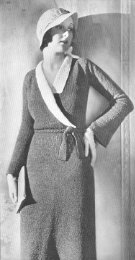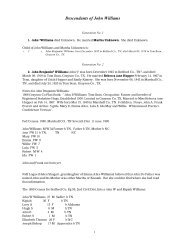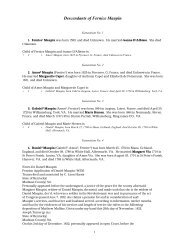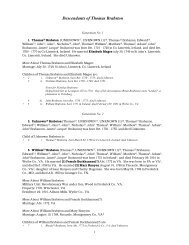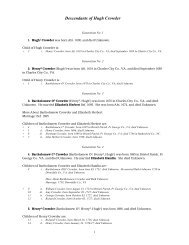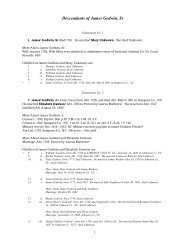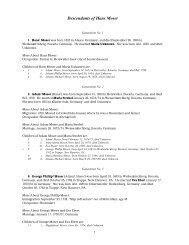Blankenship - Cemetarian
Blankenship - Cemetarian
Blankenship - Cemetarian
Create successful ePaper yourself
Turn your PDF publications into a flip-book with our unique Google optimized e-Paper software.
included specified livestock, bedding, and miscellaneous household items.<br />
Women were in great demand at this time in colonial history. Presumably the marriage of Edward<br />
Stanley to Martha Blankinship was not necessarily one of romance but rather one of friendship and<br />
convenience. Martha still had children under the age of majority when she married Mr. Stanley.<br />
According to this theory, which places Martha’s birth date about 1672 and makes her about 43 at the<br />
time of her second marriage to Edward Stanley who, at the time of the marriage would have been 66.<br />
So Martha improved her lot considerably by marrying Edward Stanley, and in the process was able to<br />
effectively provide for her under-aged children. In this postulated scenario, the fact that Mr. Stanley<br />
previously had married Martha's mother presumably meant very little. Necessity trumped any concern<br />
for social mores that otherwise might have militated against such a marriage. I would like to believe<br />
this explains the maiden name of Clay for Martha, the wife of Ralph Blankinship. However, I cannot<br />
prove it, so I do not list a surname for this Martha, wife of Ralph <strong>Blankenship</strong>. However, some<br />
undisciplined <strong>Blankenship</strong> researchers have listed Ralph Blankinship’s wife as Martha Clay. I will note<br />
the interesting fact that in many Clay families of 18th century colonial Henrico Co., Virginia there is the<br />
existence of a daughter named Martha, but not in the marriage of Hannah Wilson to Charles Clay.<br />
None, of course, unless we theorize of one who possibly married Ralph Blankinship circa 1690.<br />
Perhaps confusing, or maybe even enlightening, is the introduction of some new information recently<br />
provided me from the Hudson Family Assoc Bulletin; b 95, p 81; dated 23 Mar 1703 in which it states<br />
that Thomas Powland (the Hudson brothers guardian for the land known as Roxdale) sold Edward<br />
Stanley 235 acres of land on the north side of Swift Creek next to Robert Hudson for 3 English pounds.<br />
On the same day he sold to Robert Hudson 235 acres of the same tract. Robert Hudson sold Edward<br />
Stanley for 5 pounds a plantation on the north side of Swift Creek containing 135 acre on 30 Oct 1709.<br />
This might suggest business ties or perhaps some type of closeness between Edward Stanley and the<br />
Hudson family. It is both interesting and curious that Edward Stanley and Robert Hudson have<br />
adjoining land about six miles west of where Ralph and Martha Blankinship's homestead was located<br />
near the present day town of Chesterfield, Virginia. Equally interesting is a document found in the<br />
Henrico County Deed Book, page 262 1 Feb. 1687 which states that Frances Epes was granted 1,650<br />
acres of land for the importation of Edward Stanley and many others. So it is quite interesting that<br />
Edward Stanley arrived in Henrico County, Virginia in 1687, which is very likely the same year Ralph<br />
Blankinship was imported by Richard Kennon.<br />
Now if I were placing bets on the maiden name for Martha, wife of Ralph Blankinship, I would put<br />
more money on the Hudson surname than Clay. We know that the Clays were close to the<br />
<strong>Blankenship</strong>s. The signatures of Henry and Charles clay on the death instrutments of Ralph<br />
<strong>Blankenship</strong> and Edward Stanley may have been nothing more than the fact that they were good<br />
neighbors. When we see the Clay names on Ralph Blankinship's death inventory and on the will of<br />
Edward Stanley, Martha's second husband, it suggests to me Martha had no kinfolk living in Virginia<br />
and therefore she relied exclusively on good neighbors to witness her husbands' wills.<br />
A third and last possibility is perhaps the most likely scenario. During early colonial American history<br />
many housemaids and servants were imported to America from England. The more well-to-do families<br />
needed these young girls to care for their homes, raise their children, cook, etc. These younger women<br />
knew, of course, that their chances of finding an eligible young man to marry them were just about<br />
100% in the colonies. They really had nothing to lose and everything to gain by immigrating to the<br />
English colonies in America. I would guess that Ralph Blankinship probably married one of these<br />
young maidens who tended to one of the homes of a settler living in Bristol Parish. I further assume<br />
this young lady may have been working for the Hudson family and that they took a strong liking to<br />
this personable young woman. Then over the years Martha, who later became Martha <strong>Blankenship</strong><br />
after marrying Ralph, was still closely attached to the Hudson family. So when Ralph came into her life<br />
that relationship and bond simply carried on with the Hudson family.<br />
Until there is more proof, we will never know for sure the maiden name of Martha <strong>Blankenship</strong>, wife<br />
of the immigrant Ralph Blankinship. While there are several possibilities for who she was, the proof is<br />
6




